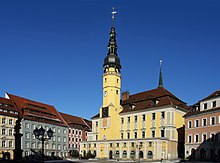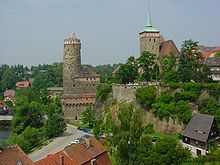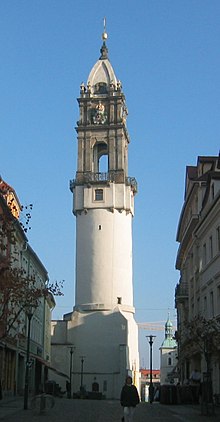Bautzen: Difference between revisions
LaaknorBot (talk | contribs) m robot Adding: zh:包岑 |
|||
| Line 78: | Line 78: | ||
=== Overview === |
=== Overview === |
||
*3rd cen. Eastern Germanic settlement. Excavations show that the region was already inhabited in the late Stone Age. |
*3rd cen. Eastern Germanic settlement. Excavations show that the region was already inhabited in the late [[Stone Age]]. |
||
*prob. 958 Erection of Ortenburg Castle atop earlier fortifications of the [[Milceni]] tribe |
*prob. 958 Erection of Ortenburg Castle atop earlier fortifications of the [[Milceni]] tribe |
||
*1002 First written mention of Bautzen |
*1002 First written mention of Bautzen |
||
Revision as of 17:03, 27 July 2009
Bautzen Budyšin | |
|---|---|
 | |
| Country | Germany |
| State | Saxony |
| Admin. region | Dresden |
| District | Bautzen - Budyšin |
| Subdivisions | 15 |
| Government | |
| • Mayor | Christian Schramm (CDU) |
| Area | |
| • Total | 66.63 km2 (25.73 sq mi) |
| Elevation | 204 m (669 ft) |
| Population (2006-12-31) | |
| • Total | 41,779 |
| • Density | 630/km2 (1,600/sq mi) |
| Time zone | UTC+01:00 (CET) |
| • Summer (DST) | UTC+02:00 (CEST) |
| Postal codes | 02625 |
| Dialling codes | 03591 |
| Vehicle registration | BZ |
| Website | www.bautzen.de |
Bautzen (pronounced , until 1868: Budissin; Upper Sorbian: ; Lower Sorbian: Budyšyn [ˈbudɨʃɨn]); is a city in eastern Saxony, Germany, and capital of the eponymous district. It is located on the Spree River. As of 2005, its population is 42,189. Asteroid 11580 Bautzen is named in honor of the city.
Bautzen is often regarded as the unofficial, but historical capital of Upper Lusatia, and it is the most important cultural center of the Sorbs, a Slavic minority.
Geography
Geographical situation
The town on River Spree is situated about 50 kilometres east of Dresden between the Lusatian highland and the lowlands in the north, amidst the region of Upper Lusatia. Northwards stretches the Bautzen reservoir, which was flooded in 1974. This is the former place of the villages Malsitz (Małšecy) and Nimschütz (Hněwsecy).
Expansion of the urban area
The old part of Bautzen is located on the plateau above the Spree, whose top is marked by the Ortenburg castle. It is bordered by the city walls. The later-built younger quarters in the east were enclosed by the city ramparts. After their removal, the city expanded further east and to the left bank of the river. However, there is only a small urban area west of the Spree until today. In the 1970s, the development areas of "Gesundbrunnen" and "Allendeviertel" were erected. After 1990, several neighbouring villages got incorporated.
Bordering municipalities
The city is bordered by Radibor, Großdubrau and Malschwitz in the North, Kubschütz in the East, Großpostwitz, Obergurig and Doberschau-Gaußig in the South, as well as Göda in the West. All of these belong to the Bautzen district.

Subdivisions
The 15 city districts are (inhabitants as of January 1, 2008):
- Innenstadt (Nutřkowne město - "City centre"), 5'181 inh.
- Südvorstadt (Južne Předměsto - "Southern outskirts"), 1'735 inh.
- Westvorstadt (Zapadne Předměsto - "Western outskirts"), 3'534 inh.
- Gesundbrunnen (Strowotna studnja), 8'321 inh.
- Nordostring (Sewjerowuchodny Wobkruh - "North-eastern ring"), 10'791 inh.
- Ostvorstadt (Wuchodne Předměsto - "Eastern outskirts"), 6'393 inh.
- Teichnitz (Wuchodne Předměsto), 386 inh.
- Nadelwitz (Nadźankecy), 274 inh.
- Burk (Bórk), 324 inh.
- Oberkaina (Hornja Kina), 835 inh.
- Niederkaina (Delnja Kina), 521 inh.
- Stiebitz (Sćijecy), 522 inh.
- Kleinwelka (Mały Wjelkow)
- Salzenforst-Bolbritz (Słona Boršć-Bolborcy)
- Auritz (Wuricy), 461 inh.


History
The first written proof of the city was in 1002. In 1018 the Peace of Bautzen was signed between the German king Henry II and the Polish prince Boleslaus I. The Treaty left Bautzen (Budziszyn in modern Polish) under Polish rule. In 1033 the city passed to the Holy Roman Empire, in 1319 to Bohemia and in 1635 to Saxony. During the Middle Ages it was a member of the Six Cities' Alliance of the Upper Lusatian cities of Görlitz, Zittau, Löbau, Kamenz, Lauban and Bautzen.
It was the site of the Napoleonic War Battle of Bautzen in 1813.
During World War II and the Nazi era, there was a subcamp of the Groß-Rosen concentration camp in Bautzen. Ernst Thälmann was imprisoned there before being deported to Buchenwald. Between 21 April and 30 April 1945, the Battle of Bautzen was fought.
Furthermore Bautzen was infamous throughout the German Democratic Republic for its penitentiaries. Bautzen I was used as an official prison, soon to be nicknamed Gelbes Elend ("Yellow Misery"), whereas the secret Bautzen II was used as a prison for prisoners of conscience. Bautzen I is still used as a prison, and Bautzen II has served as a memorial since 1993.
In 2002 the city commemorated its thousandth birthday.
Overview
- 3rd cen. Eastern Germanic settlement. Excavations show that the region was already inhabited in the late Stone Age.
- prob. 958 Erection of Ortenburg Castle atop earlier fortifications of the Milceni tribe
- 1002 First written mention of Bautzen
- 1018 Peace of Bautzen concluded between the early-feudal German city and the Polish duchy; Budziszyn(Bautzen) region remains under Polish rule until 1031
- 1076-1085 The city belongs to Upper Lusatia; Ortenburg Castle becomes the administrative centre of this area
- 1084 Wiprecht von Groitzsch moves his residence to Budissin Castle and resides here until 1091
- 1213 Town Hall built; construction of the Church of Saint Peter begins
- 1240 Existing city charter of Bautzen first mentioned in written documents
- 1336 Foundation of the Six-City League of Upper Lusatia; Bautzen, Görlitz, Löbau, Zittau, Kamenz and Lauban were members
- 1400 Craftsmen's Rebellion. Bautzen already has more than 5.300 inhabitants and is one of the most important cities in the area of modern eastern Germany
- 1408 Wenceslas, King of Bohemia, in Bautzen, 100 of the rebelling craftsmen were sentenced to death; 14 executions at the Main Market
- 1429 and 1431 Hussites lay siege to the town, but without success.
- 1469-1490 Political allegiance to Hungary (under Matthias Corvinus), after 1490 to Bohemia again
- 1524 Reformation comes to Bautzen; Church of St.Peter becomes an interdenominational church
- 1547 In the so-called Pönfall (poena case), the six cities of the Upper Lusatian League forfeit all of their privileges and holdings to the Emperor, ostensibly because they refused to provide assistance in the Schmalkaldic War (Battle of Mühlberg).
- 1635 Peace of Prague; Upper Lusatia permanenty become part of Saxony.
- 1813 Battle of Bautzen against Napoleon's army.
- 1868 "Bautzen" fixed as official designation. After the name had changed so many times (being called, by turns, Budissin, Budessen, Buticyn, Pautzen, among other forms), the name of the city remains Budysin in Sorbian.
- 1945 Bautzen is declared a fortress. Pitched street fighting until 8 May; last German tank-offensive of World War II. During the fighting, approximately 10% of the residential buildings with almost 34% of the town’s living space were destroyed. Eighteen bridges, 33 public buildings, 46 small firms and 23 larger firms were completely destroyed. Approximately 6.500 soldiers from both sides fell in the battles. According to other statistics, it is said that 350 civilians were killed during this time (Battle of Bautzen (World War II))
- 1995 Bautzen becomes a major regional administrative centre
- 2002 1000 year celebration of the original first historical record of the city

Twin cities

 Worms, since 1990
Worms, since 1990 Heidelberg, since 1991
Heidelberg, since 1991 Dreux, France, since 1992
Dreux, France, since 1992 Jablonec nad Nisou, Czech Republic, since 1993
Jablonec nad Nisou, Czech Republic, since 1993 Jelenia Góra, Poland, since 1993
Jelenia Góra, Poland, since 1993
Tourist attractions
Bautzen has a very compact and well preserved medieval town centre with a multitude of churches and towers and an impressive city wall on the steep embankment to the river Spree, with one of the oldest preserved waterworks in central Europe (built 1558).
- Sites of interest
- The Reichenturm: One of the steepest leaning and still passable towers north of the Alps
- Ortenburg Castle
- The Old Waterworks: architectural monument and museum; landmark of Bautzen
- Saint Peter's Cathedral: Eastern Germany's only historic interdenominational church edifice
- Hexenhaus (Witch's House): oldest preserved residential building (built 1604)
There are four museums including the Stadtmuseum Bautzen (lit. the Bautzen city Museum) and the Sorbisches Museum, lit. the Sorbian Museum (Sorbian: Serbski muzej).
People
External links
- Official website (in English)
- Interactive sightseeing tour through Bautzen
- City and regional portal of Bautzen and the Oberlausitz



